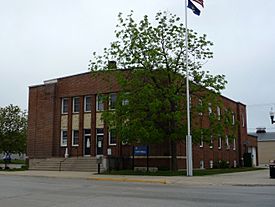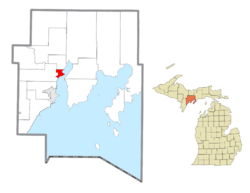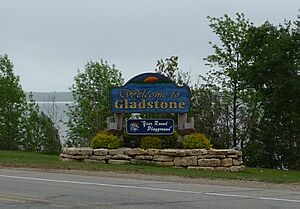Gladstone, Michigan facts for kids
Quick facts for kids
Gladstone, Michigan
|
|
|---|---|

Gladstone City Hall
|
|

Location within Delta County
|
|
| Country | United States |
| State | Michigan |
| County | Delta |
| Incorporated | 1887 (village) 1889 (city) |
| Government | |
| • Type | City commission |
| Area | |
| • Total | 7.99 sq mi (20.69 km2) |
| • Land | 5.07 sq mi (13.12 km2) |
| • Water | 2.92 sq mi (7.57 km2) |
| Elevation | 604 ft (184 m) |
| Population
(2020)
|
|
| • Total | 5,257 |
| • Density | 1,037.70/sq mi (400.67/km2) |
| Time zone | UTC-5 (Eastern (EST)) |
| • Summer (DST) | UTC-4 (EDT) |
| ZIP code(s) |
49837
|
| Area code(s) | 906 |
| FIPS code | 26-32300 |
| GNIS feature ID | 1620021 |
Gladstone is a city in Delta County, located in the Upper Peninsula of Michigan. It was first settled in 1877 and was originally called Minnewasca.
In 2020, about 5,257 people lived there. Major roads like U.S. Highway 2 and U.S. Highway 41 pass through Gladstone. These roads connect it to other towns in Michigan's Upper Peninsula. The city of Escanaba is about 14 kilometers (9 miles) south of Gladstone.
Contents
History of Gladstone
Early Settlement and Shipping
The first people to live in Michigan's Upper Peninsula were Algonquin-speaking groups.
Gladstone was first settled by European descendants in 1859. A company called Hamilton Corporation from Fayette started using the area. They used it as a port to ship and sell iron ore. The first buildings were on Saunder's Point, a small piece of land reaching into Little Bay De Noc. This point was named after Captain Nate Saunders, who fished in the bay.
From Shipping Port to Rail Center
During the 1860s and early 1870s, Gladstone grew. It became a shipping point for lumber, coal, and copper, as well as iron ore.
In 1876, the Hamilton Corporation's mine ran out of ore. The company moved its operations to a new mine further south. Because of this, more ore began to be shipped from Escanaba. Gladstone's role changed to a rail hub. Arthur Delano, who was the president of Soo Line Railroad, had a train depot built in Saunder's Point. This depot was for shipping goods by land for the Hamilton Corporation.
Gladstone officially became a village in 1887. It then became a city in 1889.
How Gladstone Got Its Name
The town was first named Minnewasca by the Soo Line Railroad. This is an Ojibwa word that means "white water." However, when the name was sent to the county and the state, a senator named W. D. Washburn stepped in. He had an interest in building the railroad. He convinced officials to change the name to Gladstone. This was done to honor the British Premier, William Ewart Gladstone.
Gladstone's Geography

Gladstone is located on a small piece of land that sticks out into Little Bay de Noc. This bay then opens up into Green Bay, which is part of Lake Michigan.
The city covers a total area of about 20.5 square kilometers (7.92 square miles). Of this, about 12.95 square kilometers (5.00 square miles) is land. The remaining 7.56 square kilometers (2.92 square miles) is water.
City Neighborhoods
Even though Gladstone is a smaller city, it has different areas.
- Downtown is where most of the local businesses are found.
- The Buckeye area is on the western side of the city. It borders the Brampton, MI township.
- The Bluff area has many new homes and Gladstone High School. The high school's sports teams are called the Braves. This means Delta County has two schools with names linked to Native American symbols. The other is the Escanaba Eskymos.
Gladstone's Climate
Gladstone has a humid continental climate. This means it has cold winters and warm summers. In January, the average temperature is around -9 degrees Celsius (16 degrees Fahrenheit). Gladstone gets about 91 centimeters (36 inches) of snow and 84 centimeters (33 inches) of rain each year.
The coldest temperature ever recorded in Gladstone was -51 degrees Celsius (-60 degrees Fahrenheit). This happened on January 7, 1896. People in Gladstone still call this storm "les morte a doigts," which means "the dead fingers." This is because many people lost fingers due to frostbite during that extreme cold. On July 19, 1992, a rare tornado hit Gladstone. It caused some damage across the city.
|
||||||||||||||||||||||||||||||||||||||||||||||||||||||||||||||||||||||||||||||||||||||||||||||||
Culture and Fun in Gladstone
Parks and Activities
Gladstone is often called "The Year Round Playground." This is because it has many parks and activities for all seasons.
- Van Cleve Park has a playground called Kid's Kingdom. It also has a skateboarding park, a baseball field, and a basketball court. There's a fitness trail, a white sand beach with a water slide, and a boardwalk. The park also has a harbor with boat ramps and a place to clean fish.
- The Gladstone Golf Course is another attraction. It goes through the Upper Peninsula Forest. Six of its 18 holes cross water.
- The Gladstone Sports Park has several baseball fields. It also has skiing and snowboarding runs, and a tubing area. The park can be rented for events like wedding receptions and high school graduation parties.
- The Days River Trails are popular for hiking and biking in spring, summer, and fall. In winter, these trails are mainly used for cross-country skiing.
Gladstone in Media
Gladstone was featured in the 2010 documentary film Catfish.
Transportation in Gladstone
Gladstone is connected by several important roads:
 US 2 is a major U.S. Highway. One part of it runs through Gladstone. It connects to Interstate 75 in St. Ignace, Michigan.
US 2 is a major U.S. Highway. One part of it runs through Gladstone. It connects to Interstate 75 in St. Ignace, Michigan. US 41 is another long U.S. Highway. It starts near Copper Harbor, Michigan, and goes all the way to Miami. Gladstone is along its route.
US 41 is another long U.S. Highway. It starts near Copper Harbor, Michigan, and goes all the way to Miami. Gladstone is along its route. M-35 is a state highway that also serves the area.
M-35 is a state highway that also serves the area.- Indian Trails offers daily bus service. You can catch a bus in Gladstone to places like St. Ignace, Ironwood, Michigan, Hancock, and Milwaukee.
Famous People from Gladstone
Many notable people have come from Gladstone, including:
- Terry Ahola, a professional ski racer and member of the U.S. Ski Team.
- Robert John Cornell, a former member of the United States House of Representatives from Wisconsin. He was also a Roman Catholic priest.
- Becky Iverson, a professional golfer.
- Frank Smith, a cartoon animator and film director.
- Bart Stupak, a former member of the United States House of Representatives from the Upper Peninsula of Michigan.
- Kevin Tapani, a professional baseball pitcher.
Population of Gladstone
| Historical population | |||
|---|---|---|---|
| Census | Pop. | %± | |
| 1890 | 1,337 | — | |
| 1900 | 3,380 | 152.8% | |
| 1910 | 4,211 | 24.6% | |
| 1920 | 4,953 | 17.6% | |
| 1930 | 5,170 | 4.4% | |
| 1940 | 4,972 | −3.8% | |
| 1950 | 4,831 | −2.8% | |
| 1960 | 5,267 | 9.0% | |
| 1970 | 5,237 | −0.6% | |
| 1980 | 4,533 | −13.4% | |
| 1990 | 4,565 | 0.7% | |
| 2000 | 5,032 | 10.2% | |
| 2010 | 4,973 | −1.2% | |
| 2020 | 5,257 | 5.7% | |
| U.S. Decennial Census | |||
Gladstone's Population in 2020
According to the 2020 census, Gladstone had 5,257 people. There were 1,880 households and 1,272 families living in the city. The population density was about 400.67 people per square kilometer (1,037.70 per square mile).
Most of the people were white (91.8%). Other groups included Native American (1.3%), Asian (0.3%), and African American (0.1%). About 5.9% of people were of two or more races. Hispanic or Latino people made up 0.7% of the population.
About 29.6% of households had children under 18. Many households (45.5%) were married couples. The average household had 2.76 people, and the average family had 3.20 people.
Gladstone's Population in 2010
In the census of 2010, Gladstone had 4,973 people. There were 2,182 households and 1,374 families. The population density was about 384 people per square kilometer (994.6 per square mile).
The racial makeup was mostly White (95.4%). Other groups included Native American (1.9%), Asian (0.3%), and African American (0.2%). About 1.8% of people were of two or more races. Hispanic or Latino people made up 1.0% of the population.
About 27.9% of households had children under 18. Many households (49.5%) were married couples. The average household size was 2.27 people, and the average family size was 2.84 people.
The average age in the city was 43.6 years. About 22.7% of residents were under 18. About 21.1% were 65 or older. The city had slightly more females (52.3%) than males (47.7%).
See also
 In Spanish: Gladstone (Míchigan) para niños
In Spanish: Gladstone (Míchigan) para niños



